It looks like you're using an Ad Blocker.
Please white-list or disable AboveTopSecret.com in your ad-blocking tool.
Thank you.
Some features of ATS will be disabled while you continue to use an ad-blocker.
share:
How this went down in historic terms in terms of legend;
In this figure within chariot from Vinca culture this symbolic Astral association with Ursa Major in the ideogram of the swastika, based upon the constellation describing the four quarters of the year, and thus also solar association, and related to the rotation of the Heavens and passages of time.

The connection with the Pleiades is seen on the three wheeler example below, assocciated with celestial portals and the feminine counterpart of the seven male sages, though in Sumeria the Apkallu were also related to the Pleiades.

The tradition of the seven sages in Sumeria as having fish and sometimes bird like qualities are almost certainly long after the event derivations from the Vinca period.

They are said to be 'seers' by virtue of being able to see the divine law which rules all creation and also sustains it.They are also said to be first Brahmans or the sons of Brahma. They have divine powers and are free from worldly pleasures, the circle of life and death and karma. They bring down to the earth the Knowledge required and Energies to strengthen the processes of Transition or Pralaya. They are the most evolved Light Beings in the Creation and the guardians of the Divine Laws. They are given more importance than the "Devatas" or the other Gods.
Sapta Rishis are the Hierarchy working under the guidance of the Highest Creative Intelligence, Parmatma
In the Hindu mythology, it is said that the stars of the Big Dipper were the seven sages called Rishis. They were happily married to seven sisters named Krttika. They originally lived all together in the northern sky. But one day, the god of fire, Agni, fell in love with the seven Krttika. Trying to forget his love, Agni wandered in the forest where he met Svaha, the star Zeta Tauri.
Svaha had a child. Rumors began to spread that six of the Rishis' wives were his mother. The seven Rishis divorced their wives. Arundhati was the only one that remained with her husband as the star Alcor. The other six Krttika went away to become the Pleiades.
In this figure within chariot from Vinca culture this symbolic Astral association with Ursa Major in the ideogram of the swastika, based upon the constellation describing the four quarters of the year, and thus also solar association, and related to the rotation of the Heavens and passages of time.

The connection with the Pleiades is seen on the three wheeler example below, assocciated with celestial portals and the feminine counterpart of the seven male sages, though in Sumeria the Apkallu were also related to the Pleiades.

The tradition of the seven sages in Sumeria as having fish and sometimes bird like qualities are almost certainly long after the event derivations from the Vinca period.
The Apkallu (Akkadian) or Abgal, (Sumerian) are seven Sumerian sages, demigods who are said to have been created by the god Enki to establish culture and give civilization to mankind. They served as priests of Enki and as advisors or sages to the earliest "kings" or rulers of Sumer before the flood. They are credited with giving mankind the Me (moral code), the crafts, and the arts. They were seen as fish-like men who emerged from the sweet water Abzu.
According to the myth, human beings were initially unaware of the benefits of culture and civilization. The god Enki sent from Dilmun,amphibious half-fish, half-human creatures, who emerged from the oceans to live with the early human beings and teach them the arts and other aspects of civilization such as writing, law, temple and city building and agriculture
Apkallu and human beings were presumably capable of conjugal relationships since after the flood, the myth states that four Apkallu appeared. These were part human and part Apkallu

edit on Kam731189vAmerica/ChicagoWednesday0931 by Kantzveldt because: (no reason given)
edit on
Kam731189vAmerica/ChicagoWednesday0931 by Kantzveldt because: (no reason given)
It's odd that you conflate Hindu tradition with Vinca culture.
It certainly does nothing for your, ahem, hypothesis.
Harte
It certainly does nothing for your, ahem, hypothesis.
Harte
a reply to: Harte
Vinca and the surrounding regional groups very much relate to the formative Indo-European steppe cultures that developed and influenced Northern Indian tradition, there is seen stylistic development of the earliest figurine types from Vinca into Indus Valley culture and throughout a substantial area of the Near East, so i don't see anything problematic for Vinca being a common source for both Hindu and Sumerian traditions of the seven sages, things have to start somewhere, unless you can suggest an alternative...?
The script types seen first developed at Vinca reappear as Proto-Sumerian script in Jemdet Nasr culture of earliest Uruk so a picture begins to emerge that there was some form of cultural transmission, or we simply ignore evidence...?
There is after all a perfectly good rendition of the Good Ship Taurus and it's crew of seven sages and their wives arriving from the general vicinity of the Pleiades from Indus Valley, these stylized figurines trace back on stylistic grounds and dating to Vinca culture, so i mean really what more could anyone want...?
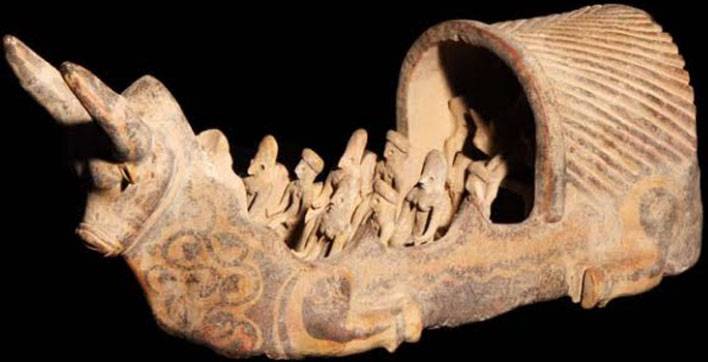
Vinca and the surrounding regional groups very much relate to the formative Indo-European steppe cultures that developed and influenced Northern Indian tradition, there is seen stylistic development of the earliest figurine types from Vinca into Indus Valley culture and throughout a substantial area of the Near East, so i don't see anything problematic for Vinca being a common source for both Hindu and Sumerian traditions of the seven sages, things have to start somewhere, unless you can suggest an alternative...?
The script types seen first developed at Vinca reappear as Proto-Sumerian script in Jemdet Nasr culture of earliest Uruk so a picture begins to emerge that there was some form of cultural transmission, or we simply ignore evidence...?
There is after all a perfectly good rendition of the Good Ship Taurus and it's crew of seven sages and their wives arriving from the general vicinity of the Pleiades from Indus Valley, these stylized figurines trace back on stylistic grounds and dating to Vinca culture, so i mean really what more could anyone want...?

edit on Kam731189vAmerica/ChicagoWednesday0931 by Kantzveldt because: (no reason given)
a reply to: Kantzveldt
The protection suit idea really does not hold any water - as stated by another poster, power rangers suits offer no protection at all. They clearly rely on training, zords and the Nylarks (sp?) etc being a bit crap.
I really CBA to look it up (and have no weblinks available) but Gimbutas clearly demonstrates (likely in "The Goddesses and Gods of Old Europe, Myths and Cult images) through numerous examples similar to those that you give (eg the Vinca figurines) that these are clothes. Clasps, hems and seams can often be seen. These are quite clearly imo examples of impressionistic art, and a world treasure.
The Squidward power ranger was Epic btw, many thanks for that.
The protection suit idea really does not hold any water - as stated by another poster, power rangers suits offer no protection at all. They clearly rely on training, zords and the Nylarks (sp?) etc being a bit crap.
I really CBA to look it up (and have no weblinks available) but Gimbutas clearly demonstrates (likely in "The Goddesses and Gods of Old Europe, Myths and Cult images) through numerous examples similar to those that you give (eg the Vinca figurines) that these are clothes. Clasps, hems and seams can often be seen. These are quite clearly imo examples of impressionistic art, and a world treasure.
The Squidward power ranger was Epic btw, many thanks for that.
originally posted by: Kantzveldt
a reply to: Harte
Vinca and the surrounding regional groups very much relate to the formative Indo-European steppe cultures that developed and influenced Northern Indian tradition, there is seen stylistic development of the earliest figurine types from Vinca into Indus Valley culture and throughout a substantial area of the Near East, so i don't see anything problematic for Vinca being a common source for both Hindu and Sumerian traditions of the seven sages, things have to start somewhere, unless you can suggest an alternative...?
The script types seen first developed at Vinca reappear as Proto-Sumerian script in Jemdet Nasr culture of earliest Uruk so a picture begins to emerge that there was some form of cultural transmission, or we simply ignore evidence...?
Despite what you seem to want there's no evidence to ignore.
What you present is evidence that there was cultural dissemination between Sumer and the Indus Valley civilization. This has been accepted as fact already.
The Vinca script looks nothing like Harappan or Proto-Sumerian.
Lastly, everybody sees the same stars in the sky.
Harte
a reply to: Harte
Vinca script is the first day in the infants class for humanity, so yes a little later but still derivative to arrive at Tartaria script, which shows close correspondence with that of Jemdet Nasr.
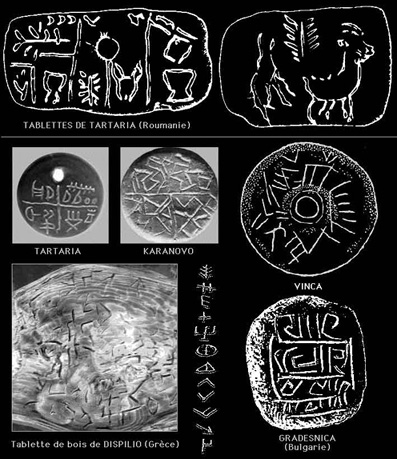
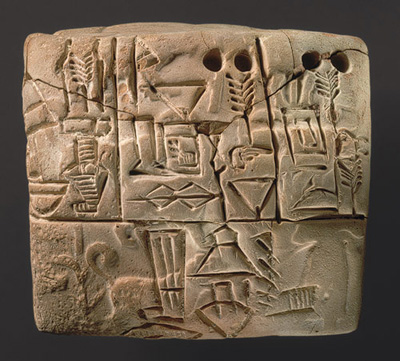
This was thought to be a possible case of Sumerian cultural dissemination into SE Europe but by dating the other way around, so why is it so unlikely that the tradition of the seven sages also derives from there and is related to the Vinca figurines, when after all these are also closely connected to the first signs and symbols as they bear such upon them...?
The seven sages were always seen in an Ante-Diluvian context, within the pre-historic period, if derivative of Vinca culture two thousand years prior to the Sumerian City states.
a reply to: skalla
So regular humans move on folks nothing to see here, or is what she suggested simply a case that if you limit yourself to already known possible explanations you will force fit an explanation within the limited paradigm you have created, simply because you have excluded other possibilities, the end result being you accept these as representations of people despite common sense.
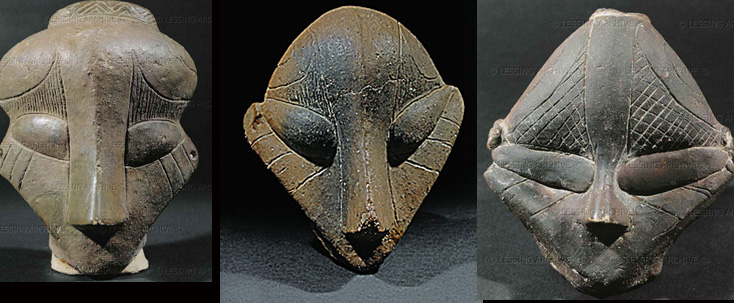
If they weren't so benevolent i'd expect them to come back and wipe out humanity for being such ungrateful and ignorant wretches..
Vinca script is the first day in the infants class for humanity, so yes a little later but still derivative to arrive at Tartaria script, which shows close correspondence with that of Jemdet Nasr.


This was thought to be a possible case of Sumerian cultural dissemination into SE Europe but by dating the other way around, so why is it so unlikely that the tradition of the seven sages also derives from there and is related to the Vinca figurines, when after all these are also closely connected to the first signs and symbols as they bear such upon them...?
The seven sages were always seen in an Ante-Diluvian context, within the pre-historic period, if derivative of Vinca culture two thousand years prior to the Sumerian City states.
a reply to: skalla
So regular humans move on folks nothing to see here, or is what she suggested simply a case that if you limit yourself to already known possible explanations you will force fit an explanation within the limited paradigm you have created, simply because you have excluded other possibilities, the end result being you accept these as representations of people despite common sense.

If they weren't so benevolent i'd expect them to come back and wipe out humanity for being such ungrateful and ignorant wretches..
edit on Kpm731189vAmerica/ChicagoWednesday0931 by Kantzveldt because: (no reason given)
a reply to: Kantzveldt
Nope, you are looking at the development of human art, which we have plenty of evidence for and many examples of their development - as opposed to an alien hypothesis for which there is only speculation.
A quick scan at some books showed me some bird/human hybrid figurines from the balkans circa 8-6kya (eg: Vinca, Near Selevac), with only slightly defined features.
Move to "The Masked Lady of Bariljevo" (Pristina) approx 6.5kya (along with many many other masked figurines).
Add the incised lines/net patterns (new to the region at that time iirc) from the second and third examples above (Predionica, approx 6.5-6 kya) and a progression in the development of the art can be seen.
Viewing such things in isolation is pointless.
ETA: When these figures are viewed from the side, it's obvious that many of the faces are in fact masks..
Nope, you are looking at the development of human art, which we have plenty of evidence for and many examples of their development - as opposed to an alien hypothesis for which there is only speculation.
A quick scan at some books showed me some bird/human hybrid figurines from the balkans circa 8-6kya (eg: Vinca, Near Selevac), with only slightly defined features.
Move to "The Masked Lady of Bariljevo" (Pristina) approx 6.5kya (along with many many other masked figurines).
Add the incised lines/net patterns (new to the region at that time iirc) from the second and third examples above (Predionica, approx 6.5-6 kya) and a progression in the development of the art can be seen.
Viewing such things in isolation is pointless.
ETA: When these figures are viewed from the side, it's obvious that many of the faces are in fact masks..
edit on 9-7-2014 by skalla because: (no reason given)
a reply to: Kantzveldt





All of them are Vinca masks - it's quite clear when the evidence is examined. The study of the development of Art is fundamental to interpreting and understanding material culture.





All of them are Vinca masks - it's quite clear when the evidence is examined. The study of the development of Art is fundamental to interpreting and understanding material culture.
I don't have an opinion one way or another on this, just a couple questions perspective-'wise' which come to mind on the 'if they existed' side
of the 'ancient aliens as Gods' concept:
First, so many early civilizations have 'Gods' who were depicted (as well as described in writings) as part fish, (the Dogon come to mind), could it be (again on the 'if' side) that the possible aliens might have parked their ship under bodies of water, traveling to land and back in some form of 'diving' gear, which would give the primitive mind the 'notion' that their 'Gods' must be part fish?
Second, on the question of figurines being representative merely of people wearing masks (rather than alien/Gods in 'helmets'), have there been masks found from the same places/time periods of those figurines?
First, so many early civilizations have 'Gods' who were depicted (as well as described in writings) as part fish, (the Dogon come to mind), could it be (again on the 'if' side) that the possible aliens might have parked their ship under bodies of water, traveling to land and back in some form of 'diving' gear, which would give the primitive mind the 'notion' that their 'Gods' must be part fish?
Second, on the question of figurines being representative merely of people wearing masks (rather than alien/Gods in 'helmets'), have there been masks found from the same places/time periods of those figurines?
It taught me that after three seasons TV shows should call it a day.
a reply to: skalla
Of course it is figures wearing masks or helmets, as well as the stylized suits with protective shoulder and knee paddings and built in features of flexibility, so the question becomes why are the figures seen posing in this relaxed manner wearing these costumes and also what lay beneath the mask....?
Here's the evidence;
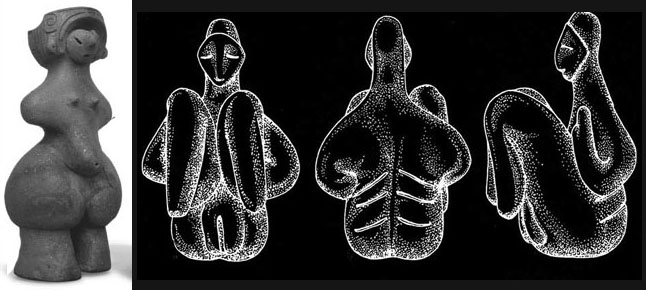


When the mask is raised the mystery only deepens, or perhaps that is what you'd expect to see...?
a reply to: lostgirl
In the Sumerian tradition the Apkallu emerge from and return into the Abzu which is a portal into the realm of water, but keep in mind that that the Heavens were also considered to be watery locations in terms of the waters above and the waters below.
There is this mask which does the rounds supposedly from Sumeria but hard to establish if genuine, i don't doubt that in the early bronze age rituals were performed in masks, but the Vinca figures have no ritual context or can be seen related to shamanic practise in any way

Of course it is figures wearing masks or helmets, as well as the stylized suits with protective shoulder and knee paddings and built in features of flexibility, so the question becomes why are the figures seen posing in this relaxed manner wearing these costumes and also what lay beneath the mask....?
Here's the evidence;



When the mask is raised the mystery only deepens, or perhaps that is what you'd expect to see...?
a reply to: lostgirl
In the Sumerian tradition the Apkallu emerge from and return into the Abzu which is a portal into the realm of water, but keep in mind that that the Heavens were also considered to be watery locations in terms of the waters above and the waters below.
There is this mask which does the rounds supposedly from Sumeria but hard to establish if genuine, i don't doubt that in the early bronze age rituals were performed in masks, but the Vinca figures have no ritual context or can be seen related to shamanic practise in any way

edit on Kpm731189vAmerica/ChicagoWednesday0931 by Kantzveldt because: (no reason given)
a reply to: lostgirl
I'm no expert on the Balkan cultures that these figurines come from, though i do have some of Marija Gimbutas' seminal works on the cultic figurines being discussed. As far as i know no life sized masks have been found yet, but for all we know they were ritually destroyed after each use, or perhaps they were made from wood or boiled leather which would be highly unlikely to survive compared to the very durable ceramic figures.
I dont have saved links on any of this stuff, but i came across this pic that illustrates a prime example that demonstrates an early mask figurine - see the artifact in figures 4 and 5, which dates from about 6000 years ago and is an early example of the type to those posted by the OP and from the same Balkan cultures.

Many of the figurines even have the holes in the sides of the mask that show how they were tied; also when viewed from behind and the side it's very clear that they are masks.
And given that we know masks are used in rituals, religion and plays (and thousands of examples are known worldwide, demonstrating archetypal human behaviour); and that humans love to make artistic representations of the events and ceremonies that are important to their cultures....... well, the rest is pretty obvious given the evidence.
I'm no expert on the Balkan cultures that these figurines come from, though i do have some of Marija Gimbutas' seminal works on the cultic figurines being discussed. As far as i know no life sized masks have been found yet, but for all we know they were ritually destroyed after each use, or perhaps they were made from wood or boiled leather which would be highly unlikely to survive compared to the very durable ceramic figures.
I dont have saved links on any of this stuff, but i came across this pic that illustrates a prime example that demonstrates an early mask figurine - see the artifact in figures 4 and 5, which dates from about 6000 years ago and is an early example of the type to those posted by the OP and from the same Balkan cultures.

Many of the figurines even have the holes in the sides of the mask that show how they were tied; also when viewed from behind and the side it's very clear that they are masks.
And given that we know masks are used in rituals, religion and plays (and thousands of examples are known worldwide, demonstrating archetypal human behaviour); and that humans love to make artistic representations of the events and ceremonies that are important to their cultures....... well, the rest is pretty obvious given the evidence.
originally posted by: Kantzveldt
a reply to: skalla
Of course it is figures wearing masks or helmets, as well as the stylized suits with protective shoulder and knee paddings and built in features of flexibility, so the question becomes why are the figures seen posing in this relaxed manner wearing these costumes and also what lay beneath the mask....?
Here's the evidence;
When the mask is raised the mystery only deepens, or perhaps that is what you'd expect to see...?
I don't see a raised mask in the examples that you provide, though the various seated positions that you reasonably interpret as relaxed are common throughout these figurines, as is a "thinker" like pose. Perhaps these were life like representations of individuals taking part in a mystery ceremony, maybe they were intended as portraits even. Not knowing the stories and specific beliefs of these peoples it is of course just guess work, but maybe they represent a scene from one of their great stories.
It is of course not unusual for figures to display their naughty bits and i dont need to explain this. Figure 3 i dont think i've seen before - is it Balkan? I've seen many anthropomorphic vessels like this, and the patterns are often interpreted as fertility related with eggs in the cosmic/amniotic waters, illustrated nicely in figure six, though some would say that it is a bird and/or snake goddess - of course these are interpretations but are formed by examination of many diverse examples where the development of motif can be traced from earlier more explicit examples to later ones where differing patterns/conventions are introduced gradually and then more widely adopted in time before (again gradually) becoming more abstract.
If you don't know them already, "The Goddesses and Gods of Old Europe" and "The Language of the Goddess" are well worth getting hold of.
a reply to: lostgirl
Just found a ceramic mask from the Vinca culture dating to about 6.5/6 thousand years ago. I cant finds it in Google Image, but it's from Leskovica near Stip in Macedonia and is pig-like (many of the ones posted are imo birds and cats) - maybe someone with better goggle fu than i can find it, but it's on p146 of Gimbutas' "Language of the Goddess".
So yeps, they had life sized ones.
Just found a ceramic mask from the Vinca culture dating to about 6.5/6 thousand years ago. I cant finds it in Google Image, but it's from Leskovica near Stip in Macedonia and is pig-like (many of the ones posted are imo birds and cats) - maybe someone with better goggle fu than i can find it, but it's on p146 of Gimbutas' "Language of the Goddess".
So yeps, they had life sized ones.
a reply to: skalla
The figures on the right if i remember correctly are Cucuteni, those on the left Jomon were there is remarkable correspondence to the SE European figurines, of course there is seen considerable interest in the sexuality of these figures there and the spiral patterns associated with the Feminine, the features of the face when seen are Ophidian.
The only context i can see for any story as you be suggest would be the one about the aliens that stopped over and took the time out of their busy schedule to have their likeness sculpted...
There is nothing to suggest any mystery cult aspect here, taking into account the greater context such figurines could be found in they are more likely to be seen sat around on easy chairs or posing in family groups with Mother holding baby, the costume being seen across all age range and gender, all the evidence suggests that is their general attire.
There are a few examples of early Sumerian seals here showing figures wearing similar masks/helmets to the Vinca figurines and similar to the photo of a possible example, little is known about them but they are intriguing.

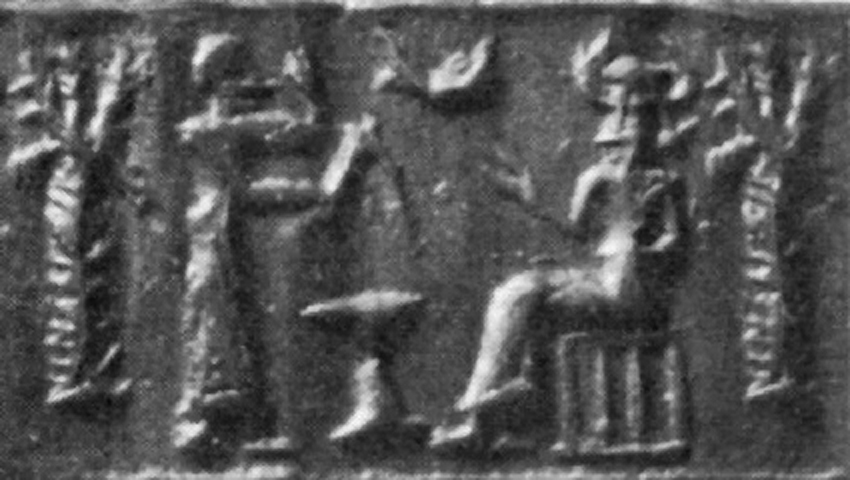

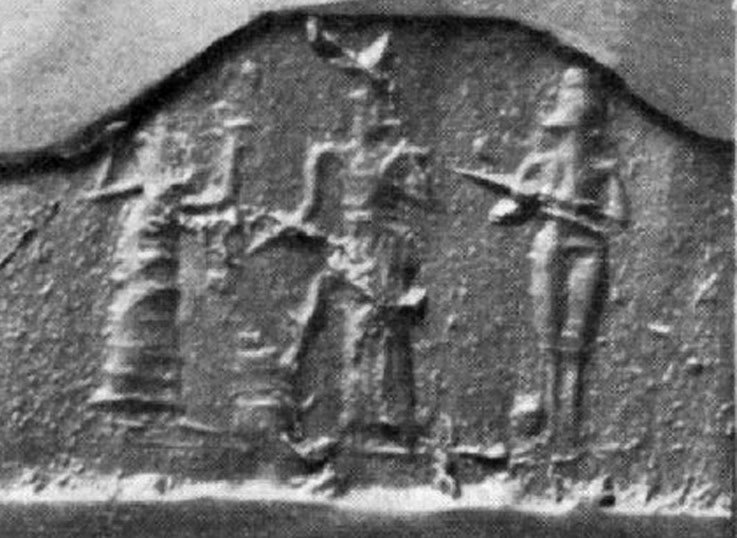
The figures on the right if i remember correctly are Cucuteni, those on the left Jomon were there is remarkable correspondence to the SE European figurines, of course there is seen considerable interest in the sexuality of these figures there and the spiral patterns associated with the Feminine, the features of the face when seen are Ophidian.
The only context i can see for any story as you be suggest would be the one about the aliens that stopped over and took the time out of their busy schedule to have their likeness sculpted...
There is nothing to suggest any mystery cult aspect here, taking into account the greater context such figurines could be found in they are more likely to be seen sat around on easy chairs or posing in family groups with Mother holding baby, the costume being seen across all age range and gender, all the evidence suggests that is their general attire.
There are a few examples of early Sumerian seals here showing figures wearing similar masks/helmets to the Vinca figurines and similar to the photo of a possible example, little is known about them but they are intriguing.




edit on Kpm731189vAmerica/ChicagoWednesday0931 by Kantzveldt because: (no reason given)
Whatever happened to artistic expression, stylized representations of beliefs and cultic practices, ranging from anamism to shamanism to various
cosmogony and theology? Why does it all have to come down to interpreting every ancient artifact literally, and only from a modern perspective? A
votive figure representing fertility now becomes a space-suited alien. Rock art painted by a peyote-chewing shaman must now be viewed as alien
overlords...
It takes researchers years, maybe even their entire lifetime, to understand the mindset of the ancient artisans who created these works, and what they represent. But I suppose it is easier (and sells more books) to re-interpret everything as having an extraterrestrial origin.
It takes researchers years, maybe even their entire lifetime, to understand the mindset of the ancient artisans who created these works, and what they represent. But I suppose it is easier (and sells more books) to re-interpret everything as having an extraterrestrial origin.
originally posted by: Blackmarketeer
Why does it all have to come down to interpreting every ancient artifact literally, and only from a modern perspective?
Because that's probably the only way armchair archaeologists can fit aliens into the equation
a reply to: Kantzveldt
Number 2 is from the Sesko culture in Thessaly and number 4 is another Vinca figurine. Number 6 is from the Blakns iirc, but i'm sick as a parrot right now and apologies for TMI but i'm rather pukey or i'd look into it further. I dont find it odd though that there are similarities to distant cultures for a great many reasons, none pertaining to ET influence - this has no bearing on my belief in life outside of earth though. It seems from you last comments that you are no longer talking alien influence?
Number 2 is from the Sesko culture in Thessaly and number 4 is another Vinca figurine. Number 6 is from the Blakns iirc, but i'm sick as a parrot right now and apologies for TMI but i'm rather pukey or i'd look into it further. I dont find it odd though that there are similarities to distant cultures for a great many reasons, none pertaining to ET influence - this has no bearing on my belief in life outside of earth though. It seems from you last comments that you are no longer talking alien influence?
edit on 9-7-2014 by skalla because: typo
new topics
-
Disney’s Snow White | Official Trailer | In Theaters March 21
Movies: 1 hours ago -
UnitedHealthcare CEO Brian Thompson shot dead in Midtown Manhattan, masked gunman at large
Other Current Events: 1 hours ago -
More NY Justice System Corruption
Social Issues and Civil Unrest: 5 hours ago
top topics
-
More NY Justice System Corruption
Social Issues and Civil Unrest: 5 hours ago, 17 flags -
US spent $151 BILLION on illegal immigration in 2023 alone: DOGE
US Political Madness: 17 hours ago, 12 flags -
CIA Whistleblower Kevin Shipp claims CIA was involved in MH370's disappearance
General Conspiracies: 17 hours ago, 8 flags -
Would Democrats Be in Better Shape if They Had Replaced Joe Biden with Kamala Harris in July 2024.
US Political Madness: 13 hours ago, 7 flags -
President Biden is Touring Africa. Why?
Politicians & People: 17 hours ago, 6 flags -
UnitedHealthcare CEO Brian Thompson shot dead in Midtown Manhattan, masked gunman at large
Other Current Events: 1 hours ago, 6 flags -
Disney’s Snow White | Official Trailer | In Theaters March 21
Movies: 1 hours ago, 3 flags
active topics
-
More NY Justice System Corruption
Social Issues and Civil Unrest • 16 • : network dude -
UnitedHealthcare CEO Brian Thompson shot dead in Midtown Manhattan, masked gunman at large
Other Current Events • 15 • : nugget1 -
Salvatore Pais confirms science in MH370 videos are real during live stream
General Conspiracies • 90 • : Arbitrageur -
Disney’s Snow White | Official Trailer | In Theaters March 21
Movies • 6 • : angelchemuel -
Great Barrier Reef Attacks and Sinks New Zealand Frigate HMNZS Manawanui
Weaponry • 70 • : fringeofthefringe -
Alien warfare predicted for December 3 2024
Aliens and UFOs • 87 • : Arbitrageur -
President Biden is Touring Africa. Why?
Politicians & People • 15 • : Coelacanth55 -
US spent $151 BILLION on illegal immigration in 2023 alone: DOGE
US Political Madness • 5 • : marg6043 -
Would Democrats Be in Better Shape if They Had Replaced Joe Biden with Kamala Harris in July 2024.
US Political Madness • 24 • : WeMustCare -
CIA Whistleblower Kevin Shipp claims CIA was involved in MH370's disappearance
General Conspiracies • 16 • : b0kal0ka

